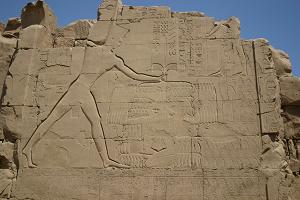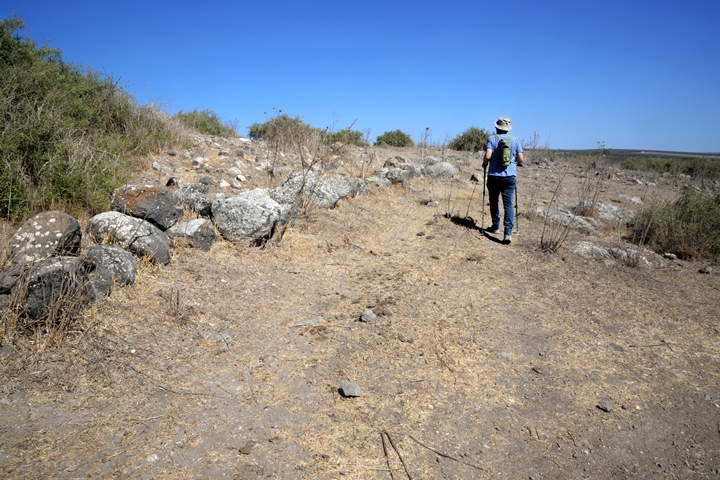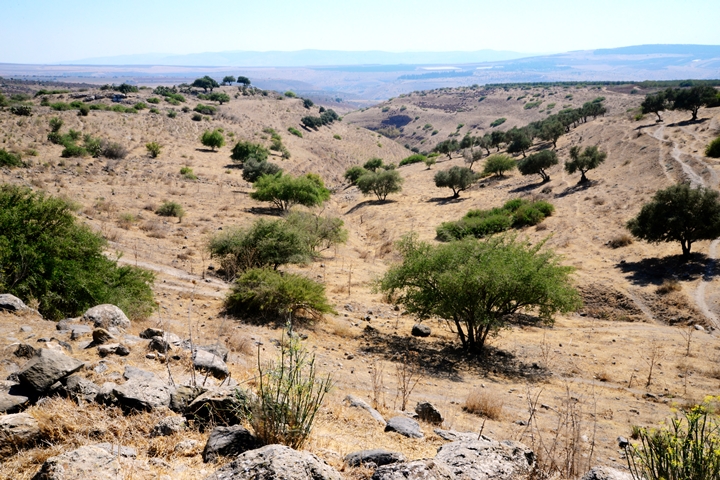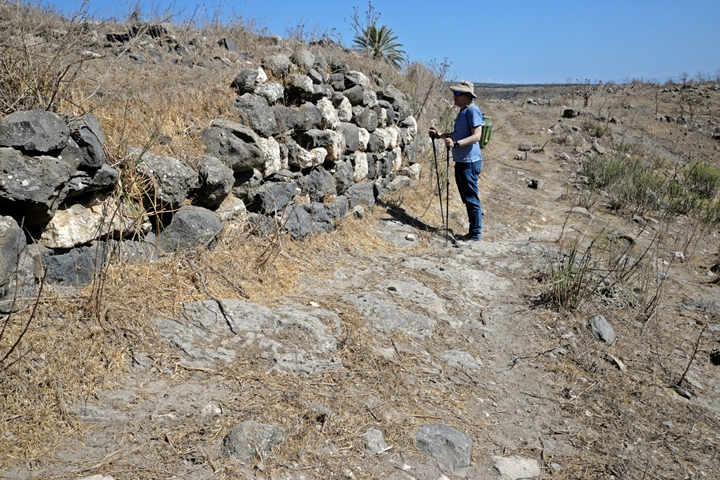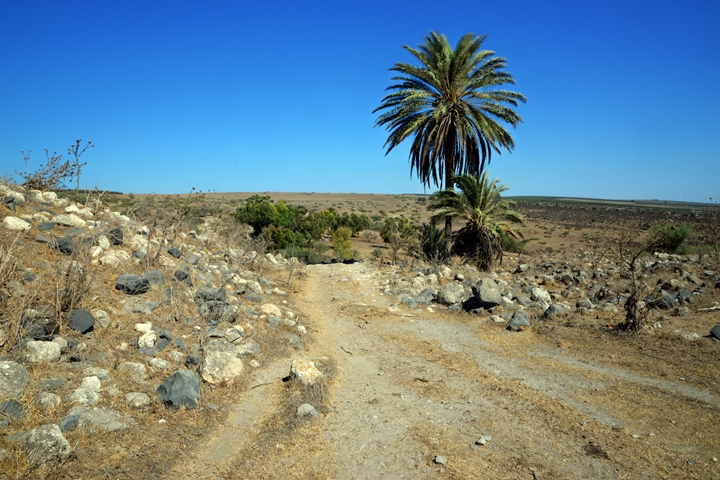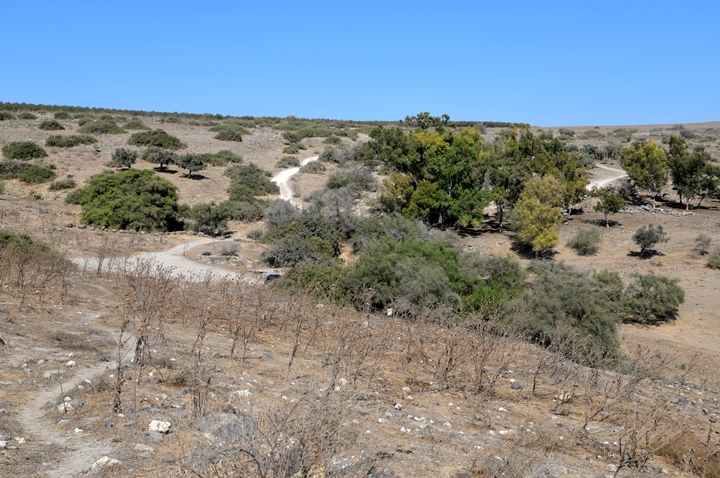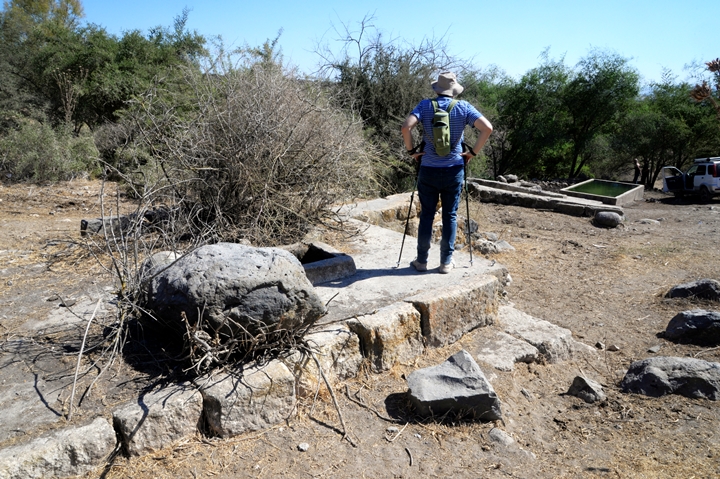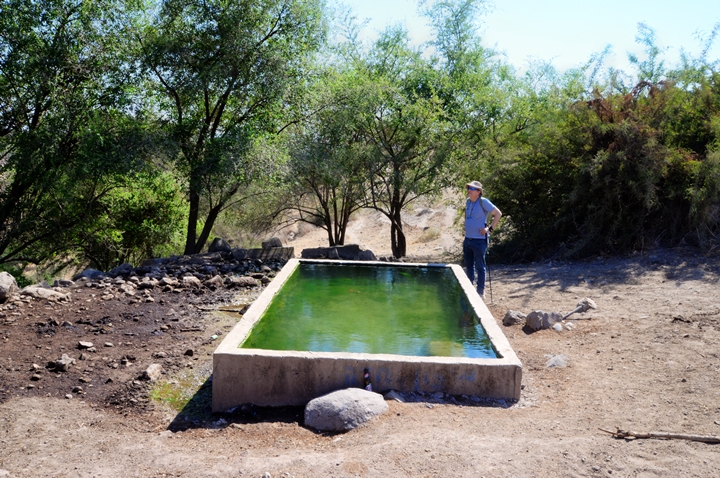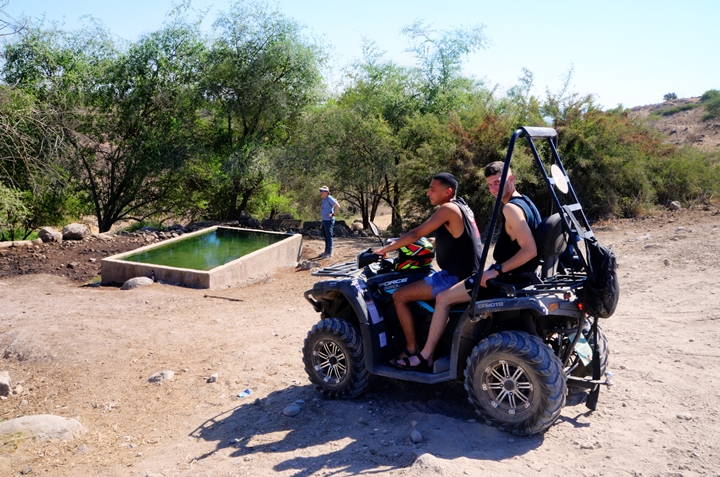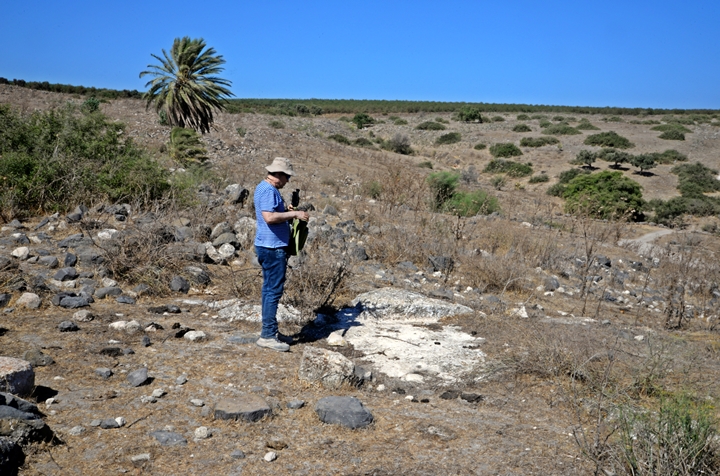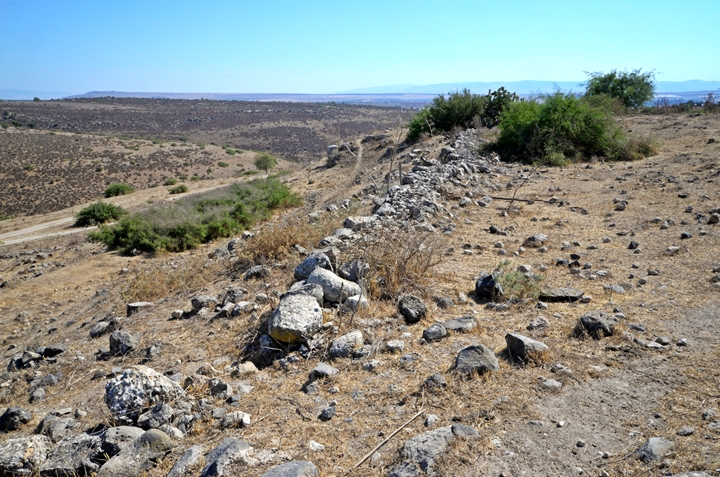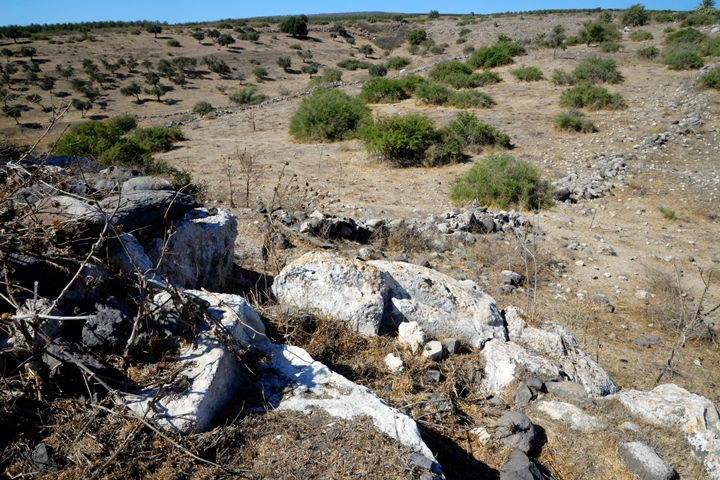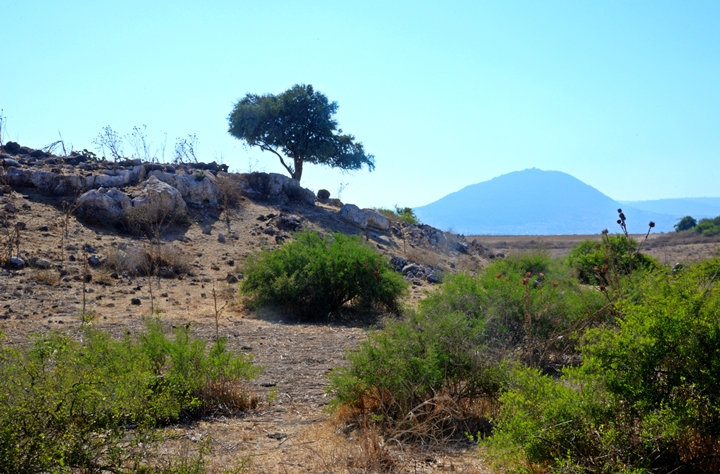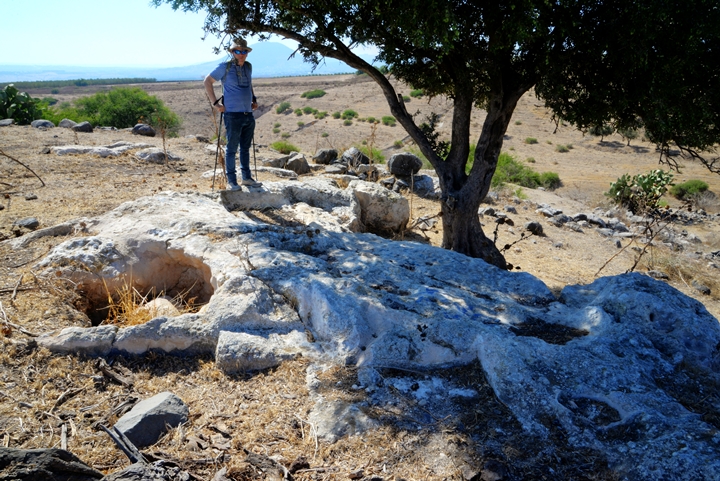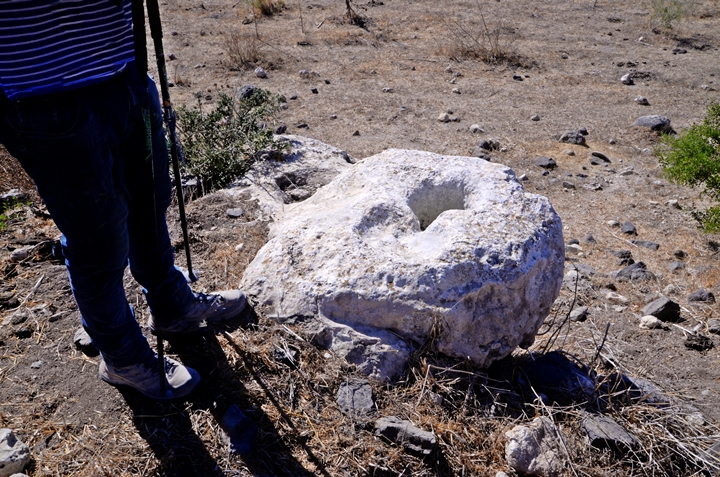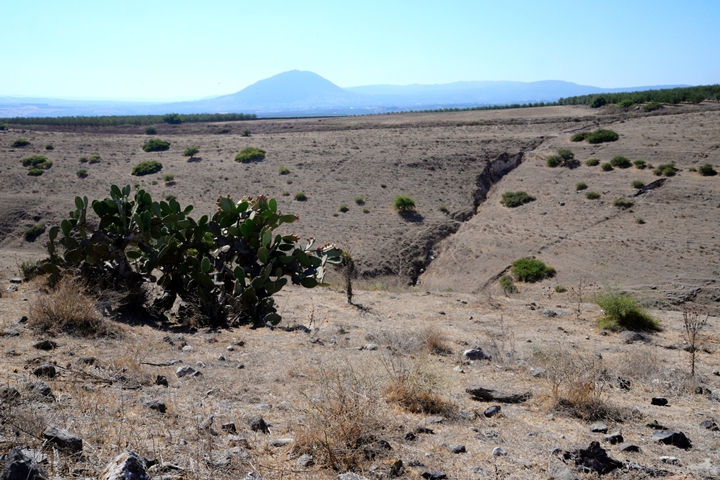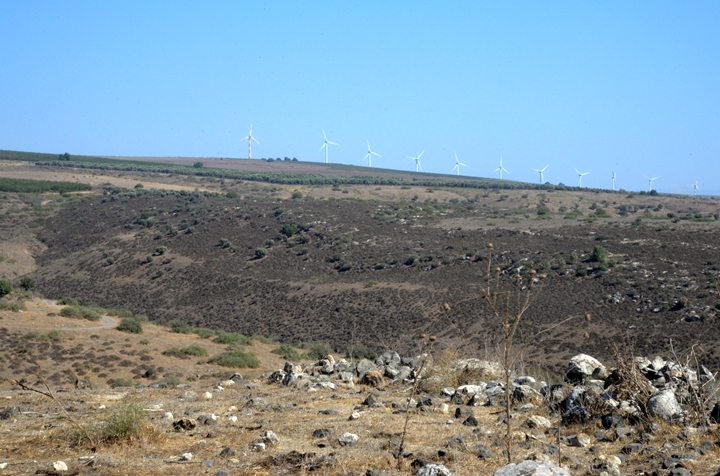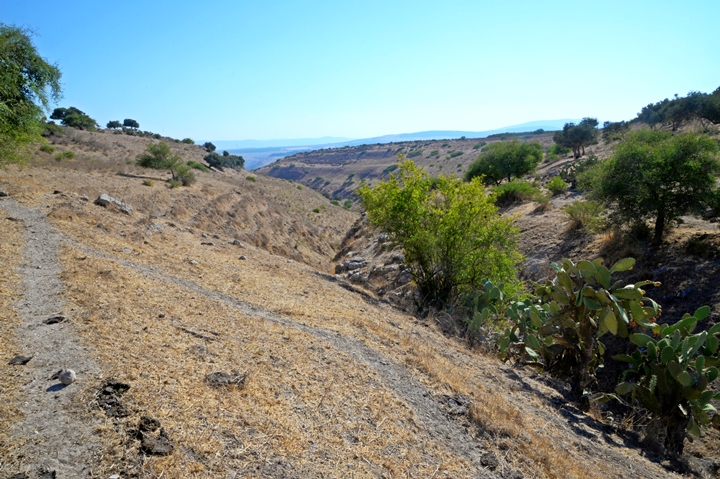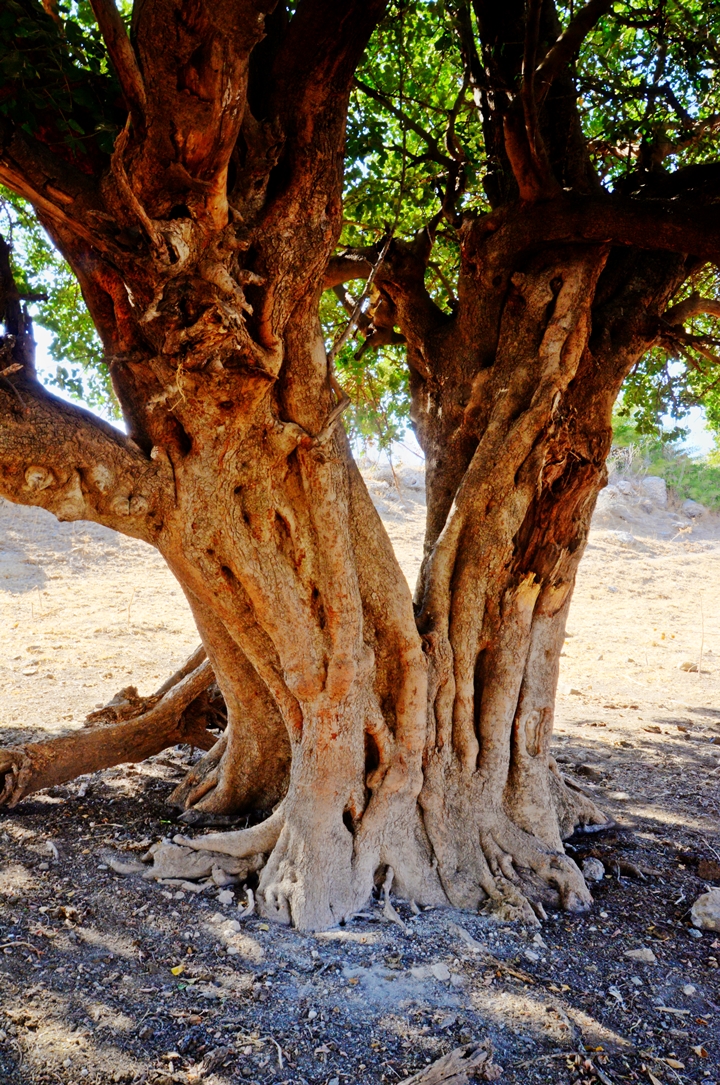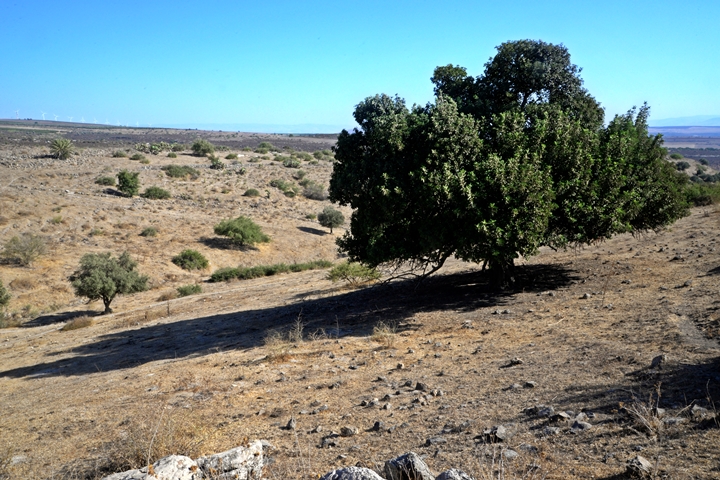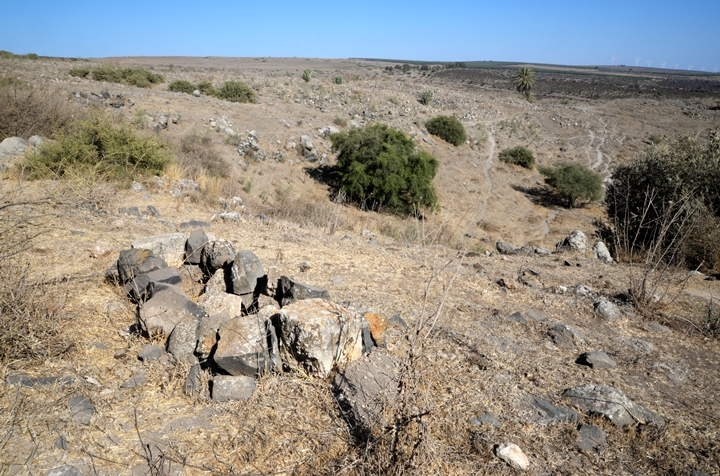A multi-period archaeological site located on the plateau above Yavne’el, named after its spring (Ein Haddah).
Home > Sites > Yizreel Valley > Tel Ein Haddah
Contents:
Background
Location
History
Identification
Photos
* Aerial Views
* Arab village
* Spring
* The Tel
* West side
Links
Etymology
Background:
A multi-period archaeological site located on the plateau above Yavnael, 8km east of Mt. Tabor.
(Joshua 19: 17): “And the fourth lot came out to Issachar…. And Remeth, and Engannim, and Enhaddah, and Bethpazzez”.
Location:
An aerial map of the site is shown here, with Tel Ein Haddah in the center. On its north side are the ruins of the Arabic village – Hadatha. The spring, which gave its name to the site, is located on the north east side.
There are several ways to reach this remote location – dirt roads from Sharona (from the north), Sirin (from east) or Kfar Kisch (from south).
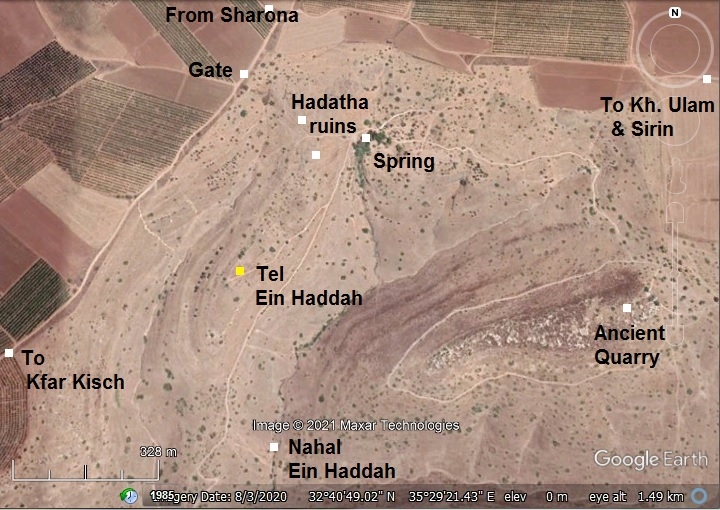
History:
- Bronze period (3150-1200BC)
The city, naturally protected by deep valleys on both sides, was a fortified city during the periods of the Middle Bronze IIa/b (2000-1550 BC), Late Bronze I (1550-1300 BC) and Late Bronze IIa/b (1300-1200).
It may have been one of the cities conquered by the Egyptian pharaoh Thutmose III (reigned 1479 BC to 1425 BC) who listed “Hadat” as one of the 117 cities conquered during his inquest to the north. On the wall in Karnak are illustrations of Canaanite princes, depicted with hands tied behind their backs, and their city names appear in Egyptian hieroglyphics. The neighboring MB city – Anharath (Tel Rekhesh) – also appears on this royal monument.
Thutmose III smiting his enemies (7th pylon in Karnak). Photo by Markh; public domain.
- Iron Age (1200-586 BC)
The city continued to thrive in the Iron Age I (1200-1000BC). Ein Haddah was a Biblical city within the inheritance of the tribe of Issachar (Joshua 19: 17):
“And the fourth lot came out to Issachar…. And Remeth, and Engannim, and Enhaddah, and Bethpazzez”.
It was named after the spring that provided its life in this dry area – Ein (spring) Haddah. The spring continues to provide year round water, located on the north east side.
A Biblical map shows the location of the site , between Mt. Tabor to the west and the Jordan river to the east, overlooking Jabneel.
According to D. Dorsey (The Roads and Highways of ancient Israel”), the city was located on a major Bronze/Iron age west/east road (“T2”), connecting Via Maris at the foothills of Mt. Tabor to Tell Obeidiya on the shores of the Sea of Galilee.
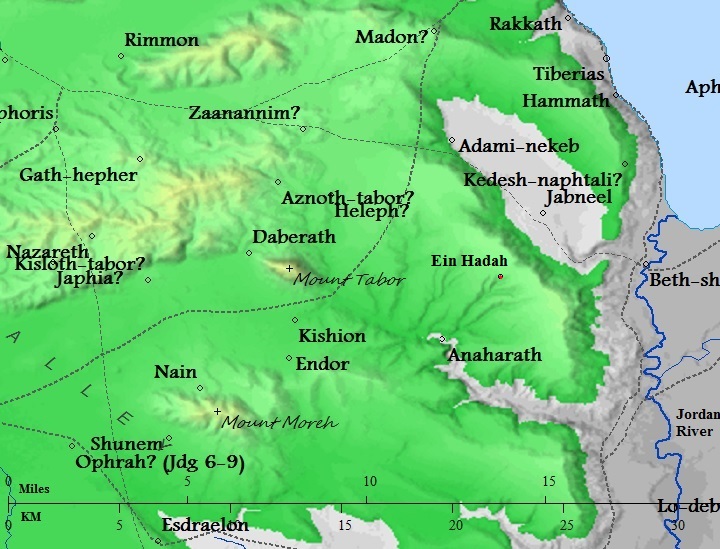
Map of the area around the site – from Canaanite/ Israelite to Roman period (based on Bible Mapper 3.0)
- Late Iron Age
The Assyrian empire conquered the North Kingdom of Israel in 732 BC, destroying most of the cities and villages in the land. They exiled some of the population and introduced harsh taxation. (2 Kings 15: 29):
“In the days of Pekah king of Israel came Tiglathpileser king of Assyria, and took Ijon, and Abelbethmaachah, and Janoah, and Kedesh, and Hazor, and Gilead, and Galilee, all the land of Naphtali, and carried them captive to Assyria”.
- Roman/Byzantine period (to 7th/8th century AD)
A new village at Ein Haddah was built during the Roman/Byzantine period. Hewn stones and columns were found in the northern part of the site, at the area of the ruins of the Arab village. Mosaic floor stones are scattered on the foothill above the spring. These imply the presence of a public structure, such as a Roman period synagogue. Note that a number of Jewish villages existed in the nearby area during the Roman/Byzantine period, such as , Sirin and Kfar-Yamma and Tel Rekhesh.
- Ayyubid/Mameluke periods
The village was repopulated during the Ayyubid period following the defeat of the Crusaders in 1187. It was one of the Al-Hija villages, built with stones collected from the earlier structures. Hussam ad-Din Abu al-Hija was a Kurdish lieutenant that fought in Saladin’s army. After the wars, he retired back to Iraq, but his relatives received lands and established several villages in the Galilee (Hadatha, Kaukab Abu al-Hija, Sirin, Ruweis) and Carmel coast (Ein Hud).
- Ottoman Period
During the Ottoman period the village was populated by immigrants from Algeria. The village was named Hadatha (El Hadetheh), an Arabic name that preserved the name of the ancient city. The village continued until 1948, its ruins are scattered on the north side of the ancient Tel.
- PEF Survey:
Conder and Kitchener surveyed this area during the Survey of Western Palestine (SWP), commissioned by the Palestine Exploration Fund (PEF) in 1873. A section of their map is seen here, with the site marked as “el Hadetheh” at altitude 735 ft. It is linked on its west side to Sarona (modern Sharona) and Madher (modern ruins of a Crusader and Ottoman village), and a descent road leads east to Yemma (modern Yavne’el) and to the Sea of Galilee.
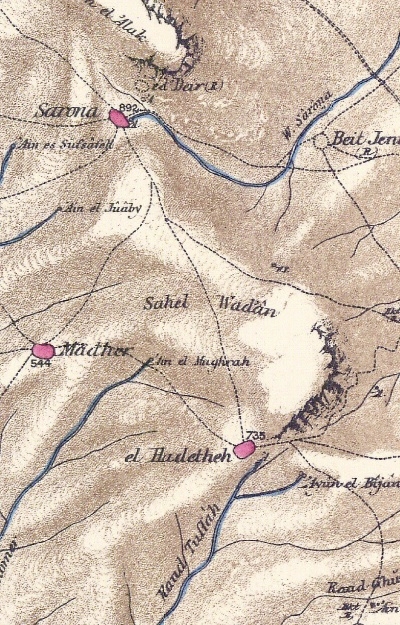
Part of map Sheet 6 of Survey of Western Palestine,
by Conder and Kitchener, 1872-1877.
(Published 1880, reprinted by LifeintheHolyLand.com)
The PEF report wrote about the spring (Volume 1, p.378):
“Spring on south-east side ; good supply of water, perennial ; a small stream flowing from it in winter and spring”.
They also quoted Geurin who reviewed the state of the village (Volume 1, p, 384):
‘ Some of the houses, which are still inhabited, have been constructed of good cut stones taken from some old buildings and mixed with small materials. On the slopes of the hill are found some ten shafts of columns lying scattered about the ground. They are the remains of a monument totally destroyed.’—Guerin.
- British mandate
A map published in the 1940s shows the area around the village “Hadatha”. The spring (‘Ein el Hadatha) is located on its east side. The houses are built to the west of the spring. The Tel to the south of the village is marked as “Et Tell”. The road leading from Sharona is marked by a double dashed line – the same route used today to get to the ruins.
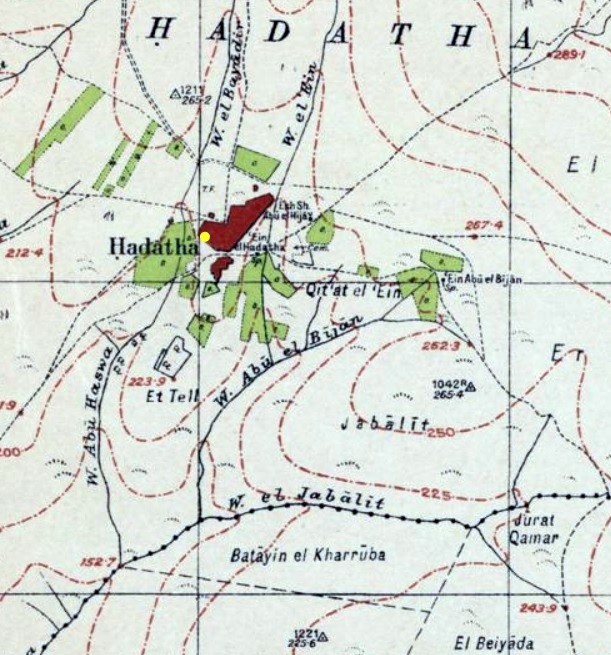
https://palopenmaps.org – Palestine 1940s 1:20,000 map
In 1921, during the British mandate, the inspectors wrote about the village (Link): “Houses are partly built of ancient stones. Cut stones and shafts of columns are scattered over the village. The spring is covered with a vault of well hewn stones. Near it are lying oil presses of basalt”.
- Modern period
The site is an open public area. It was surveyed (although not published), but not yet excavated. Hikers and Bikers get here to dip into the waters of the spring.
Photos:
(a) Aerial views
This is an aerial view of Tel, looking south. Two valleys cut deep on both sides of the ridge. Traces of the city walls are seen along the peripheral side. According the contour, it seems there were two parallel walls at two heights.
The next view is also oriented to the south, but covers a larger area. In the middle of the hill is a large raised section – perhaps the “upper city”.
Another view is towards the north. The spring is located on the right side. Ruins of the Arab village of Hadatha are located at the end of the ridge and on the hillside above it.
![]() A drone flight over the site is seen here. The drone views the area of the ancient mound to the south side of the ruins of the Arab village.
A drone flight over the site is seen here. The drone views the area of the ancient mound to the south side of the ruins of the Arab village.
Another aerial view, focusing on the Teal, is in this video.
(b) Arab Village
We approached the site via a dirt road from Sharona, then entered into the fenced area on its north west side. Sections of walls and ruins of structures are seen above the path.
Ruins of the Arab village of Hadatha are scattered along the path, overlooking the valley below.
Uncle Ronnie stands in front of one of the few standing walls. This wall is composed of black basalt and white limestone stones – a typical style (“Ablaq” =speckled) that was common in the Mameluke and Ottoman periods.
The path leads to the north eastern edge of the ruined village.
An impressive palm tree stands here with its new offspring.
The spring that is located at the eastern edge of the ruins, at the bottom of the foothill.
(c) Ein Hadah spring
A perennial spring on the north east side of the site was the main supply of water to the settlements that were established around it. In this dry land – water is life.
In the past a vaulted spring house was built over it. This is seen in an old photo of 1942 (link). However, now only the foundations are left.
A water trough was built here to provide water to the cattle.
A water basin, 5m long and 2m wide, stores the spring water. Inside it are several happy gold fish.
Visitors come here to enjoy the cool and refreshing waters.
(d) The Tel
On the south side is a elongated ridge that is enclosed by the two valleys on its east and west sides.
On the hillside are two parallel walls – perhaps the remains of the Bronze period city walls.
In the middle of the Tel is an elevated section, that is separated from the north and south sides. Is this the “upper city” of the ancient Tel?
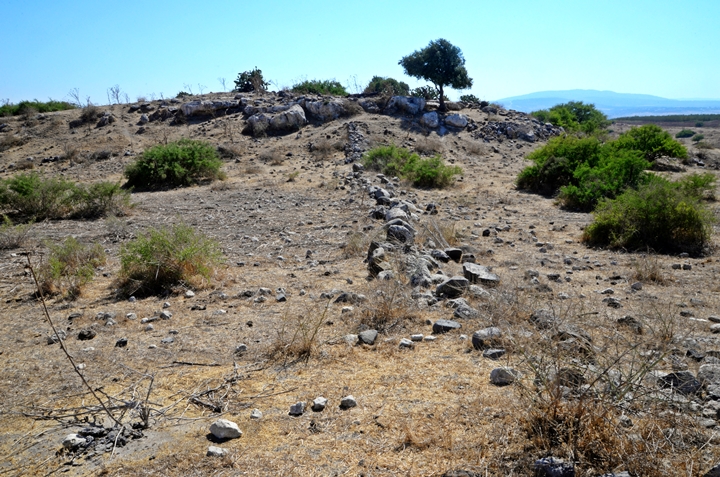
Next is a view, from the elevated section, towards the north:
The next photo is a view at this section towards the east. Notice the height difference between the ground on the left side, where an olive tree stands, and the right side.
In the far background is Mt. Tabor.
Under the olive tree, at the edge of the elevated section, are remains of agriculture installations cut into the rock.
Yet another installation nearby, probably an opening to a cistern:
On the west side of the Tel is the deep gorge of the stream. In the far background is Mt. Tabor
On the east side (below) is another deep gorge of Nahal Ein Hadah.
In the far background are the wind energy mills of Sirin ridge. Indeed, the wind here is very powerful. You can feel it while standing on the mound here in Ein Hadah.
(e) West side
We walked back thru the gorge on the west side of the Tel.
On the west side of the valley is a large Carob (Harub) tree.
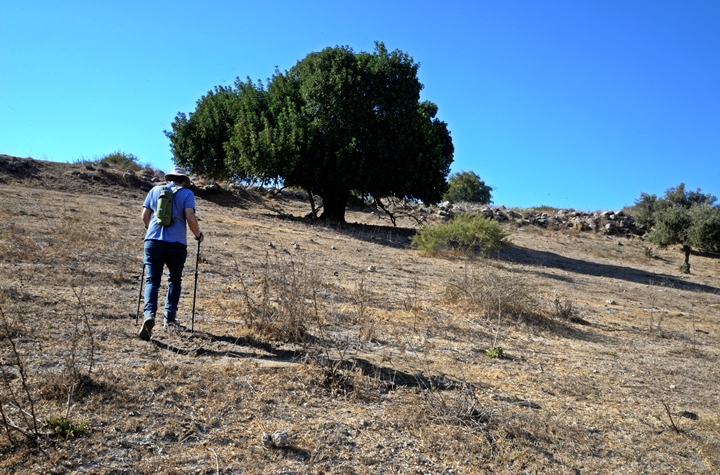
It has a thick bark with multiple sprouts.
Another view of the carob tree and the Tel behind it:
At the side of the tree is an old Arab graveyard, with a view of the ruins of the Arab village.
Links and references:
* References:
- Tel Ein Haddah – IAA best sites (Hebrew)
- British era archives (IAA archives, under Hadatha folder)
* Internal:
- Drone Aerial views – collection of Biblical sites from the air
- BibleWalks YouTube channel
Etymology (behind the name):
- Ein – Hebrew for spring (‘Ain in Arabic)
- Haddah – Hebrew: חדה (meaning sharp)
- Yavne’el (Jabnael) – Moshav established in 1901. Hebrew: “G-D builds”. Taken from the name of a biblical city (Joshua 19:33). Its former name was “Yemma”.
BibleWalks.com – exploring the ancient sites of Israel
Tel Rekhesh<<<—previous Yizreel Valley site—<<< All Sites>>>—next site—>>> Harod spring
This page was last updated on Oct 9, 2022 (Add new drone video)
Sponsored links:
